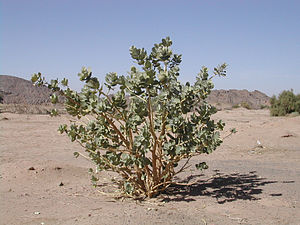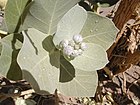Note: This is a project under development. The articles on this wiki are just being initiated and broadly incomplete. You can Help creating new pages.
Calotropis procera
Calotropis procera tree is a large. It grows upto 4 metres tall. The plant can sometimes produce a single bole that is free of branches for up to the first 2.5 metres.
Uses
Parts Used
Chemical Composition
Chemical composition of the volatile oil of traditionally useful Calotropis procera which is reported for the first time in literature consist of nine identified compounds in leaf, and ten in stem, which are respectively responsible for 93.9% and 86.4% of leaf and stem oils. [2]
Common names
| Language | Common name |
|---|---|
| Kannada | Bili ekkada gida |
| Hindi | Aak, Mudar |
| Malayalam | Erikku |
| Tamil | Vellai erukkan |
| Telugu | Erra jilledu |
| Marathi | Mandara |
| Gujarathi | |
| Punjabi | |
| Kashmiri | |
| Sanskrit | Adityapushpika |
| English | Rubber Bush, Apple of sodom |
Properties
Reference: Dravya - Substance, Rasa - Taste, Guna - Qualities, Veerya - Potency, Vipaka - Post-digesion effect, Karma - Pharmacological activity, Prabhava - Therepeutics.
Dravya
Rasa
Guna
Veerya
Vipaka
Karma
Prabhava
Habit
Identification
Leaf
{{Leaf|Opposite|Broadly elliptic|It is Varying between ovate and ob-ovate,Its size is 15cm long and 10cm broad}[3]
Flower
| Type | Size | Color and composition | Stamen | More information |
|---|---|---|---|---|
| Waxy White | 5 | Purple tipped inside and with a central purplish crown |
Fruit
| Type | Size | Mass | Appearance | Seeds | More information |
|---|---|---|---|---|---|
| Inflated | 8-12cm | Grey-Green | Many | It contains numerous seeds with tufts of long silky hairs at one end |
Other features
List of Ayurvedic medicine in which the herb is used
Where to get the saplings
Mode of Propagation
How to plant/cultivate
A plant of the semi-arid tropics and subtropics, it is found growing at elevations from sea level to 1,300 metres. It grows best in areas where the mean annual rainfall is in the range 300 - 400mm.[5]
Commonly seen growing in areas
Photo Gallery
References
- ↑ Karnataka Aushadhiya Sasyagalu By Dr.Maagadi R Gurudeva, Page no:245
- ↑ Chemical constituents
- ↑ [Morphology]
- ↑ Cite error: Invalid
<ref>tag; no text was provided for refs namedIdentification - ↑ Cultivation
External Links
- Pages with reference errors
- Ayurvedic Herbs known to be helpful to treat Boils
- Ayurvedic Herbs known to be helpful to treat Infected wounds
- Ayurvedic Herbs known to be helpful to treat Skin problems
- Ayurvedic Herbs known to be helpful to treat Asthma
- Ayurvedic Herbs known to be helpful to treat Earache
- Ayurvedic Herbs known to be helpful to treat Stomachache
- Ayurvedic Herbs known to be helpful to treat Arthritis
- Herbs with Leaves used in medicine
- Herbs with common name in Kannada
- Herbs with common name in Hindi
- Herbs with common name in Malayalam
- Herbs with common name in Tamil
- Herbs with common name in Telugu
- Herbs with common name in Marathi
- Herbs with common name in Sanskrit
- Herbs with common name in English
- Habit - Shrub
- Index of Plants which can be propagated by Seeds
- Herbs that are commonly seen in the region of Along degraded roadsides
- Herbs that are commonly seen in the region of Lagoon edges
- Herbs that are commonly seen in the region of Overgrazed native pastures
- Herbs that are commonly seen in the region of Sandy soils
- Herbs
- Pages without herbs images






